


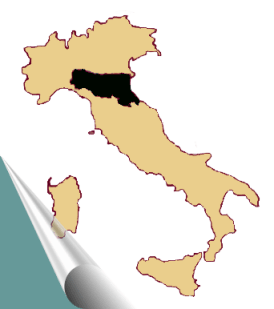
This is one of the largest Italian regions (the
sixth), an intermediate zone linking the north with the centre of the country,
the part of continental Italy joining the Italian peninsula; as such, it
is of great importance from the point of view of communications.
Stretching as far as the Adriatic sea to the east, EmiliaRomagna borders
with Veneto to the north-east, with Lombardy to the north and north-west,
with Piedmont and Liguria to the west, with Tuscany to the south and with
the Marches and the Republic of San Marino to the south-east, and there
is close coincidence of administrative and physical boundaries, delineated
by easily distinguishable natural features: the Po river to the north (except
for the Oltrepò Mantovano, part of Lombardy), the Apennine ridge
separating the Po Valley slopes from the Tuscany-Marches to the south, and
the Adriatic coast to the east.
The Natural Environment
Emilia-Romagna is a region with a relatively simple
morphology constituted of only two distinct parts: along the boundary with
Liguria, Tuscany and the Marches, rise the Tusco-Emilian Apennines, at their
feet a large stretch of the Po Valley, south of the river and the entire
Romagnola plain. The Apennines are not particularly high here (Mount Cimone,
2,165 m., Monte Cusna, 2,121 m.) and are rarely rugged. From the watershed,
a series of nearly parallel ridges thrusts outwards towards the plain, progressively
decreasing in height, sharply separated from the transverse river valleys.
Beyond the extreme outlying hills lie the undulations of the stony upper
plain, formed by the fusion of fluvial detritus, beyond which extends the
wide fertile alluvial plain. Of the great swamps, which at one time characterized
the lower Emilia and Romagna plain before systematic regulation of the waterways,
remain only the Valleys of Comacchio and the stretches of water belonging
to the Po Delta.
Except for this river, which flows along the northern boundary of the region,
all the water courses are of a torrential nature. In autumn and spring they
are in spate while the water level is at a minimum in summer. They flow
from the Apennine watershed, cutting parallel down hill before reaching
the plain and flowing from the right into the Po (Tidone, Trebbia, Nure,
Arda, Taro, Parma, Enza, Secchia, Panaro), or directly into the Adriatic
Sea (Reno, Lamone, Savio).
The climate of Emilia-Romagna has sub-continental characteristics, with
cold winters and hot summers, moderated, however, by sea breezes along the
Adriatic, while the temperatures are closely affected by altitude in the
Apennine region. The rainfall, more abundant in autumn and spring, increases
progressively from the plain to the mountainous areas, where values may
rise, above 3,000 mm./year. Fog is frequent on the plains in the cold
season.
Natural vegetation has been greatly reduced by agriculture. The forests,
at one time very extensive, today are small and cover only 17.2 percent
of the region: almost absent from the plains, with the exception of the
beautiful pine forests (those of Cervia and Ravenna are two of the most
famous), the Mesola forest and a few wetlands, they appear on the outlying
hills, with white oak, chestnut and Turkey oak up to approximately 900 m.
Above this height, up to 1,600 m., lie beechwoods, with a variety of other
species (mountain ash, white hornbeam, mountain elm, etc.), beyond which
bilberries, juniper and gentian are found. One of the most important Apennine
environments is that of the Casentinesi forests, bordering with Tuscany
(in which two-thirds lie).
The fauna, partly introduced, includes red and roe deer, also indigenous
animals, such as the fallow deer and moufflon. Other mammals present are
the wildcat, badger and squirrel. One of the region's most important wetlands
is Punte Alberete, between Ravenna and the Comacchio valley, characterized
by an abundance of marshland vegetation with predominantly forest trees
on the dunes and aquatic flora in the hollows. This is probably one of the
most extensive and remarkable waterlogged forests in Italy, whit white poplar,
white willow, elm, ash and many other trees.
In addition, there are varieties of shrubs and colourful flowers, with stretches
of cane-brakes, bulrushes and reed beds and typical waterside flowers, such
as the marsh iris, and aquatic flowers, like the water-lily. The wildlife
includes numerous birds (particularly waders, duck and other waterside birds),
large numbers of amphibians (most important are, the swamp turtle and the
crested newt) as well as fish. In the hills the argillaceous nature of the
soil, together with climatic conditions and surface features, has given
rise to characteristic forms of erosion caused by the combined activity
of free-flowing and channelled waters, and the so-called calanchi, long
narrow, close-set runnels, divided by sharp vertical walls. This gives entire
slopes a curiously impressive appearance, and being devoid of vegetation,
an air of desolation.
An unusual environment, as far as scenery and its morphological characteristics
are concerned, and exceptional from mineralogical point of view, is that
of the `Gessi Bolognesi', round Bologna: among clay and Miocenic sulphurous
chalk formations, an exceptional variety of chalk forms are found, in grottoes,
dolines and hidden valleys. The vegetation is interesting due to the presence
of warm climate species, such as the holly oak, fillirea variabilis, buckthorn
and toad flax; at least 550 different plants have been listed, including
rare species such as the Cheilantes Persica fern, once believed to be extinct.
Another environment of great interest to the naturalist, at the margins
of the Bolognese Apennines, is that of the salse (the most beautiful and
famous are those of Nirano, near Fiorano Modenese), small mud cones or cracks
that expel muddy flows sometimes with a bituminous content, associated with
underground hydrocarbon deposits.
Population and Economy
With regards to population distribution, two zones
are easily distinguished: the hills and mountains, thinly populated, and
less suitable for economic exploitation, and the plains,characterized by
an excellent communication network, the possibility of intensive farming
andideal conditions for industrial develop ment. The most important, all
built in this zone, exceptFerrara and Ravenna, lie along the great axis
constituted by the Via Emilia: Piacenza, Parma, Reggio, Modena, Bologna,
Imola, Faenza, Forlì, Cesena and Rimini.
The regional dialects of Emilia and Romagna form part of the large family
of the Italo-Celtic dialects of the northern regions of Italy and conserve
a certain homogeneous purity, except in the Province of Piacenza where the
Emilian dialect has Lombard elements, and the Province of Forlì,
where the Romagna dialect is influenced by that of the Marches. Environmental
conditions are generally good, for this is an area of low industrial concentration;
problems of air and water pollution occur in the industrial area of Ravenna
and in some belts along the lower reaches of the Po. Of the productive sectors,
agriculture is undoubtedly a profitable activity; the soil is naturally
fertile, cultivation techniques are highly advanced, and the cooperative
system enables smallholders to slash production costs. 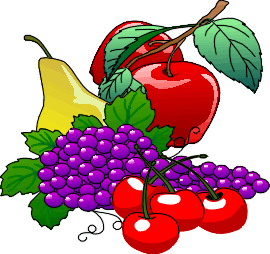
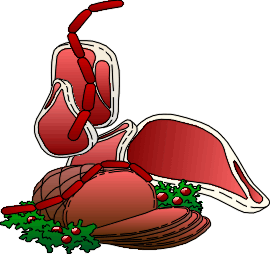
There is a plentiful production of fruit (pears, peaches and apples), wheat
(the region is the leading national producer), sugar beet, vegetables and
grapes. Cattle and pig breeding is a consistent factor. Fishing is also
relevant (approximately one quarter of the national production). The industrial
sector is characterized by a significant number of small and medium-sized
firms evenly distributed throughout the territory, based principally on
the transformation of agricultural products. Pasta, cheese, salami and canning
factories are important, and their products true symbols of the region,
eg. Parmigiano-Reggiano cheese (Parmesan), hams (Parma, Langhirano),
zampone (pig's trotter stuffed with meat, Modena), pasta and Lambrusco wine
are famous throughout the world. 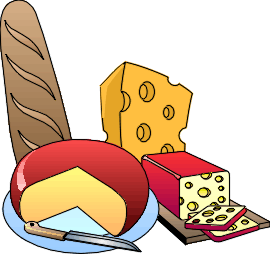
No less important, however, are other branches
of industry: engineering (farm machinery, luxury and racing cars), clothing
(Carpi), ceramics (Sassuolo) and chemicals (Ferrara, Ravenna). There are
numerous thermoelectrical power stations; at Caorso (Piacenza) the biggest
thermonuclear plant in Italy is in operation. Underground resources are
limited to deposits of natural gas, particularly in the Provinces of Ravenna,
Ferrara and Piacenza (Cortemaggiore). The service sector is active in the
commerce of agricultural products, the principal distribution centre (also
for foreign trade) being Bologna.
Tourism is of great importance and along the Adriatic coast it is the main
source of income. The geographical position of Emilia-Romagna, which lies
between North and Central Italy, has determined a high degree of development
of communications. The roads connect with the ancient Via Emilia and the
Milan-Bologna-Florence-Rome motorway; the Adriatic and Ferrara motorways
branch off at Bologna, and the Bologna railway junction is one of the most
important in Italy.
There are three domestic airports: Bologna-Borgo Panigale, Forlì
and Rimini, the latter principally handling charter traffic.
Tourism
Apart from Bologna and the other major urban centres,
tourism in Emilia-Romagna is principally directed to the Adriatic coast,
where from the Comacchio Valleys to the Marches boundary lie some thirty
famous and busy seaside resorts. The beaches of Romagna have, in fact, always
attracted tourists from home and abroad, (especially the Germans and Northern
Europeans).
Milano Marittima, Cervia, Cesenatico, Bellaria, Rimini, Riccione, Cattolica,
the Lidi Ferraresi and Ravennati, the most important resorts are oriented
to what cannot be called the `élite' and prefer to cater for the
masses. This policy is facilitated by large sandy beaches, shallow waters
stretching for a distance from the shore, a welcoming and vast hinterland
and by the network of efficient family-run small and medium-sized hotels,
where prices are very reasonable, and the service adequate and efficient.
In addition all the centres have discotheques, night clubs, typical bars
and restaurants and places of entertainment. Cultural events include those
organised by Riccione (literary awards), Cattolica, Rimini and Comacchio.
The immediate hinterland offers important examples of art, especially in
the famous Abbazia di Pomposa on the Strada Romea, the Byzantine Basilica
of Sant'Apollinare in Classe, near Ravenna and the small and picturesque
Republic of San Marino, rich in history and traditions with restful landscapes.
The visitor is advised to visit the Renaissance Tempio Malatestiano, by
Leon Battista Alberti, in Rimini, and the interesting historical town centre.
The great Bosco della Mesola not far from the Po Delta, now a natural park,
is a remarkable reminder of what the ancient forests on the plain must once
have been, while enthusiastic photography of the amazingly interesting birdlife
is a pastime to be indulged in the oasis of Punte Alberete or in the Comacchio
Valleys. There are many thermal spas in this region, generally with sulphurous,
sodio-bromine-iodic and sodio-iodic springs including Salsomaggiore, in
the Parma Apennines, famous for its mud therapy and hydromassage; nearby
Tabiano Terme, specializing in the treatment of the respiratory system and
metabolism disorders, Porretta Terme, in the upper Reno valley. A relaxing
holiday can also be enjoyed in the Apennine resorts, in an incredibly green
untouched landscape. Here lie Pievepelago and Lizzano in Belvedere, and,
in the same area, a number of localities with reasonably good winter sports
facilities, such as Cerreto Laghi, in the Reggio Apennines, Corno delle
Scale in the Bologna Apennines and notably the Monte Cimone area, near Sestola
in Frignano.
The countryside is dotted with charming little towns and villages of artistic
and environmental interest such as Castell'Arquato, Bobbio and Grazzano
Visconti (exact reconstruction of a medieval village) in the province of
Piacenza; Sassuolo, with the Palazzo degli Estensi, and Nonantola, with
its famous abbey, in the Modena area; Lugo and Faenza, also famous for the
International Ceramics Museum, in the province of Ravenna; Cento, between
Bologna and Ferrara, with its rich Civic Art Gallery.
Bologna (EMILIA-ROMAGNA)
Capital of the Emilia-Romagna region, Bologna is
situated 54 m. above sea level, in a pleasant position at the foot of the
outlying Apennine ramifications, at the mouth of the plain of the Reno and
Savena valleys.
Founded in the 6th century BC. by the Etruscans, with the name Felsina,
on a previous Italic settlement, two centuries later it became a settlement
of the Boii Gauls; subsequently (191 BC.), already known by the name of
Bononia, it became fully romanized. After the fall of the Empire, it was
under Byzantine, Lombard and Frankish rule until it became a free municipality
(11th century).

The foundation of the famous university, one of the oldest in the world,
transformed the city into the cultural capital of Europe: at the same time,
Bologna assumed the precise urbanistic and architectural character still
evident today, expanding within successive sets of city walls. In 1513,
after being the object of struggles, between the various Signorie and the
Papacy, it became part of the Papal State to which it remained loyal, except
during the Napoleonic period, until 1859 when, following the Second War
of Independence and the Plebiscites, it became a part of the Kingdom of
Italy.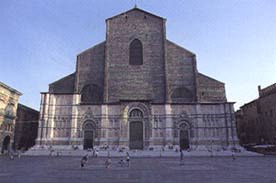
The city is rich in monuments and works of art, notably: Piazza Maggiore, the heart of Bologna, San Petronio (Gothic, 14th-17th century), the Palazzo dei Notai (14th century), the Palazzo Comunale (13th-16th century), the Palazzo del Podestà (15th century), the Palazzo di Re Enzo (13th century) and the Fontana del Nettuno (Renaissance fountain, by Giambologna). The Cappella Bentivoglio (Renaissance, works of art by Veneziano and Ludovico Carracci), San Giacomo Maggiore (13th-14th century, Gothic), San Domenico (13th century, with works of art by N. Pisano, Michelangelo and Filippino Lippi), San Francesco (12th century), the Archiginnasio (16th century), Santa Maria dei Servi (14th-15th century), the Palazzo della Mercanzia (14th century) and the `torri pendenti' (12th century leaning towers: degli Asinelli, 98 m., view of the city, and della Garisenda, 48 m.), are all worth a visit.
The economy of Bologna is based on an active industrial
sector which, traditionally strong in the transformation of agricultural
products and in animal husbandry, also includes the footwear, textile, engineering,
chemical printing and publishing industries, as well as on flourishing commercial
activity.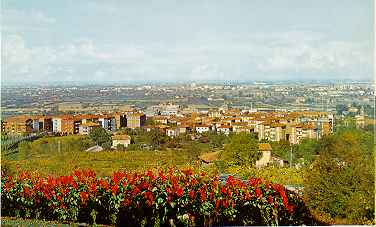
Events: Trades Fair (June; other exhibitions during the year), Childrens's Book Fair (March), Bologna's musical festivals (summer), Corteo Storico di Monte San Pietro.
Famous People: Agostino Carracci (artist, 1557-1602), Annibale Carracci (artist, 1560-1609), Lodovico Carracci (artist, 1555-1619), Guido Reni (artist, 1575-1642), Luigi Galvani (physicist, 1737-1798), Ulisse Aldrovandi (philosopher and physician, 1522-1605), Guglielmo Marconi (inventor, 1874-1937), Marcello Malpighi (physician, 1628-1694), Benedetto XV (Pope, 1675-1758), Ottorino Respighi (musician, 1879-1936), Giorgio Morandi (artist,1890-1964) and Pier Paolo Pasolini (film director and writer, 1922-1975).
Cultural Institutions: University, Galleria d'Arte
Moderna, (modern art gallery), Teatro Comunale (theatre), Casa di Carducci,
with library; Pinacoteca Nazionale (art gallery, featuring works of art,
among others, by Giotto, Guido Reni, Parmigianino, Carracci, Raffaello and
Tiziano), Museo Civico Archeologico (archeological museum), Museo Storico
della Tappezzeria (tapestry museum), Museo delle Navi.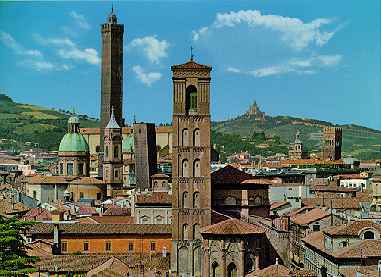
In the Province: Imola (Museo delle Armi e delle Maioliche, Museo Archeologico, interesting historical centre), Lizzano in Belvedere (Apennine holiday resort), Porretta Terme (thermal spa), Marzabotto (Etruscan remains, museum), Castiglione dei Pepoli.
Ferrara (EMILIA-ROMAGNA)
Situated 9 m. above sea level, surrounded by a
fertile plain in the north-eastern part of the region, slightly below the
course of the Po river. Of probable medieval origin, the city began to acquire
a certain importance at the time of the comuni (12th century). In 1240,
the Estenses rose to power and under them Ferrara enjoyed its period of
greatest splendour. In fact, the Dukes turned the city into a centre of
culture at European level, receiving artists and poets including Ariosto
and Tasso at court; in the 16th century, on the initiative of Ercole I d'Este,
the city underwent well-planned urban development round the medieval centre.
In 1597, it was annexed to the Papal States, losing part of its importance
and, after the Napoleonic period, became united with the Kingdom of Italy
in 1860. 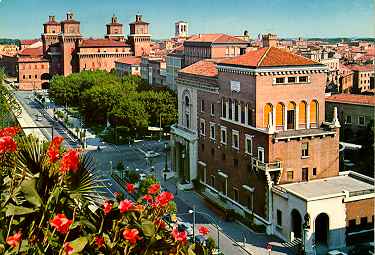
Monuments: Castello Estense (castle, 14th-16th century), Cattedrale (12th-13th
century, outstanding works of art), Palazzo dei Diamanti (16th century),
Palazzo di Lodovico il Moro (16th century palace), Palazzina di Marfisa,
(16th century), Palazzo di Schifanoia (14th-15th century).
As far as the economy is concerned, Ferrara is an active commercial centre
with national and international trade in fruit and horticultural products,
for which it is particularly well equipped (warehousing facilities, efficient
transport sector, international biennial fair of fruit cultivation). Industry
is present in the food (sugar, pasta factories and flour mills), engineering
(agricultural machinery) and petrochemical sectors.
Events: Mostra Canina Internazionale (international dog show in March),
Palio di San Giorgio (May), modern art exhibition at the Palazzo dei Diamanti,
exhibitions at the Castello Estense, Premio Letterario Estense (literary
prize in September).
Famous People: Cosmè Tura (artist, 1432-1495), Gerolamo Savonarola
(politician and orator, 1452-1498), Borso d'Este (overlord of Ferrara, 1413-1471),
Filippo de Pisis (artist, 1896-1956).
Cultural Institutions: University; Civica Galleria d'Arte Modena (modern
art gallery), Museo del Risorgimento and Pinacoteca Nazionale (art gallery),
all at the Palazzo dei Diamanti; Museo Civico and Museo Archeologico Nazionale
(Etruscan remains), museums; Casa dell'Ariosto.
In the Province: Cento (industrial centre, Galleria d'Arte Moderna), Comacchio
(environmental interest), Argenta (Pinacoteca-art gallery), Bondeno, Mesola
(Mesola forest) and Codigoro (in the vicinity, Pomposa Abbey).
Forlì (EMILIA-ROMAGNA)
This town lies 34 m. above sea level, on the Via
Emilia, in the fertile plain between the Montone and Ronco rivers, at the
foot of the outlying ramifications of the Tusco-Emilian Apennines. The city
was a Roman municipium with the name of Forum Livii; later, after forming
part in the exarchate of Ravenna in medieval times, it increased in importance
towards the 11th century when it became a municipality.
Monuments: Chiesa di San Mercuriale (12th-13th century Romanesque church),
Duomo (Neo-classical), Rocca di San Ravaldino (14th-15th century), Chiesa
di Sant'Antonio Vecchio (Romanesque church), Chiesa di San Filippo (15th
century), Palazzo del Podestà (15th century, Romanesque-Gothic).
The economy of Forlì is based on the commerce of the area's agricultural
products and on livestock, the food industry, closely linked to local agriculture
(canning, sugar factories and mills) and on the chemical and textile industries.
Events: Annual poultry exhibition during the trades fair (September).
Famous People: Melozzo da Forlì (artist, 1438-1494), Piero Maroncelli
(patriot, 1793-1846), G. Battista Morgagni (physician, 1682-1771), Aurelio
Saffi (patriot, 1819-1890).
Cultural Institutions: Pinacoteca Comunale (paintings by Melozzo, Guercino
and Palmezzano), Galleria d'Arte Moderna (modern art gallery), Sala Verzocchi
(art gallery), Quadreria Pedriali, Museo Civico ed Archeologico (museum),
Biblioteca Comunale Aurelio Saffi (town library).
In the Province: Cesena (agricultural and industrial centre; Rocca Malatestiana,
fortress (housing the Museo della Civiltà Contadina Romagnola-rural
life museum, and Biblioteca Malatestiana), Riccione, Cattolica and Cesenatico
(seaside resorts), Bertinoro (medieval fortress), Forlimpopoli (medieval
fortress and archeological museum), Rimini (seaside resort; Arco di Augusto,
Tempio Malatestiano by L. B. Alberti).
Modena (EMILIA-ROMAGNA)
 Situated
at 34 m. above sea level on the plain confined by the rivers Secchia and
Panaro; the Via Emilia runs through the urban area. Ancient centre of the
Ligurians, in 183 BC. the city became a Roman colony, known as Mutina, an
important agricultural and commercial market. After the Barbarian invasions,
it flourished again under the Canossas (11th-12th century), as a free municipality
and later, in the 13th century, passed under the rule of the Estensis, who
held it until the French Revolution. After 1815 Modena was an Austrian possession
until 1860 when it was annexed to the Kingdom of Italy.
Situated
at 34 m. above sea level on the plain confined by the rivers Secchia and
Panaro; the Via Emilia runs through the urban area. Ancient centre of the
Ligurians, in 183 BC. the city became a Roman colony, known as Mutina, an
important agricultural and commercial market. After the Barbarian invasions,
it flourished again under the Canossas (11th-12th century), as a free municipality
and later, in the 13th century, passed under the rule of the Estensis, who
held it until the French Revolution. After 1815 Modena was an Austrian possession
until 1860 when it was annexed to the Kingdom of Italy.
Monuments: The Duomo (Romanesque - 12th-13th century, sculptures by Wiligelmo),
the Ghirlandine (a tower, 86 m. high-14th century), the Palazzo Ducale (17th
century, now seat of the Military Academy), the Palazzo Comunale (12th century),
the church of San Francesco (Gothic), the Pantheon degli Estensi (17th century).
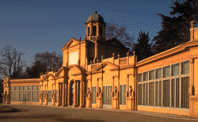
With regard to the economy, Modena is an important
commercial centre, and a junction of road and rail communications. In addition
to traditional agricultural activities and animal husbandry, other flourishing
industries are notably in the food (hams, zamponi, Lambrusco wine, dairy
products), engineering (agricultural machinery), chemical, and electronics
sectors.
Events: Carnival with the masques of the `Famiglia Pavironica', the agricultural
fair (April).
Famous People: Alessandro Tassoni (poet, 1565-1655), Paolo Ferrari (playwright,
1822-1889), Ciro Menotti (patriot, 1798-1831), Gabriele Falloppio (anatomist,
1523-1562)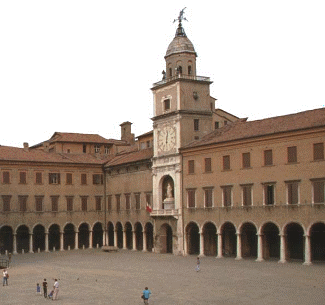 .
.
Cultural Institutions: (14th-18th century, paintings of the Emilian and
Venetian school and by Carracci, Tintoretto, Veronese, Reni, etc.), Museo
Estense, Museo Archeologico (archeological museum), Galleria Campori, Museo
Lapidario (lapidary museum), Biblioteca Estense (library), Museo del Risorgimento
(historical museum), botanical garden, Museo Mineralogico (mineralogical
museum), Museo Paleozoologico (paleo-zoological museum), University (founded
in the 12th century).
In the Province: Carpi (agricultural and industrial centre), Sassuolo (ceramic
industry, production of `Nocino', a walnut liqueur), Maranello (Ferrari
racing cars), Vignola (famous for its cherries), Mirandola, Pavullo nel
Frignano.
Parma (EMILIA-ROMAGNA)
Parma lies 57 m. above sea level on the Via Emilia,
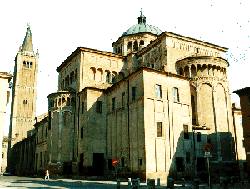 near the point where the Baganza
torrent flows into the Parma torrent, surrounded by fertile land.
near the point where the Baganza
torrent flows into the Parma torrent, surrounded by fertile land.
Of probable Etruscan origin, it became a Roman colony in 183 BC.: at the
fall of the Empire it was occupied by the Goths and later by the Byzantines
and Lombards.
A free municipality until the beginning of the 14th century, it successively
passed into the possession of the da Correggio, Estense, Visconti and Sforza
families until, in 1545, it became the capital of the Duchy of Parma and
Piacenza, constituted by Pope Paul III for his nephew Pier Luigi Farnese.
When this dynasty died out in 1731, the Duchy passed to the Bourbons, maintaining
its independence, except during the Napoleonic period, until 1860 when it
became part of the Kingdom of Italy.
Monuments: Duomo (12th century, Romanesque, works of art by Correggio
and Antelami), Battistero (12th century baptistry), San Giovanni Evangelista
(16th century, paintings by Correggio and Parmigianino), Madonna della Steccata
(Renaissance), Palazzo del Vescovado (13th century), Camera di San Paolo
(frescoes by Correggio), Palazzo della Pilotta (16th century).
As far as the economy is concerned, Parma is an active centre agricultural
and market town; it also has a highly specialized industrial sector, particularly
active in food (salami factories, cheese, pasta, canning), engineering (agricultural
machinery), fertilizers and food packaging; publishing, building, chemical,
pharmaceutical, glass, clothing and footwear industries are also present.
Events: Various food fairs, opera season and puppet shows at the Teatro
Regio, International competition for young opera singers.
Famous People: Benedetto Antelami (architect and sculptor, 12th century),
Francesco Mazzola known as `il Parmigianino' (artist, 1503-1540), the aristocratic
Farnese family, Vittorio Bottego (explorer, 1850-1897), Ildebrando Pizzetti
(musician, 1880-1968), Arturo Toscanini (orchestra conductor, 1867-1957),
Renzo Pezzani (poet and writer, 1898-1951), Giuseppe Verdi (musician opera
composer 1813-1901).
Cultural Institutions: University (founded in the 13th century), Conservatorio
(conservatory), Accademia di Belle Arti (acad emy of fine arts), Archivio
di Stato (State archives), Museo Archeologico Nazionale (archeological museum),
Galleria Nazionale (works of art by Correggio, Parmigianino, Tiepolo, Canaletto
and Titian), Museo Lombardi.
In the Province: Colorno (Palazzo dei Farnese, Museo Etnografico della Civiltà
Contadina-rural life museum-Felino (local salami), Fidenza (agricultural
and industrial centre), Salsomaggiore Terme (thermal spa), Busseto (4 km
from G. Verdi's birthplace).
Piacenza
(EMILIA-ROMAGNA)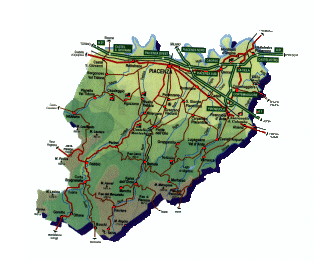
The town (61 m.) is situated near the confluence
of the Trebbia and Po rivers, in the northern part of the region at the
Lombardy boundary.
Inhabited since ancient times, it was the Roman `Placentia', of which the
historical centre still conserves the urban layout. Piacenza is an important
road junction and commercial node. After the Barbarian (Goths and Lombards),
Frankish and Imperial periods, it became a free municipality until (12th
century) it was an object of contention between the Signorie; in 1332 it
formed part of the Duchy of Milan. In 1512, Piacenza was ruled by the Popes;
Paul III later turned it into a Duchy together with Parma (1545), granting
it to the Farnese family. Except for the Napoleonic period, it remained
an independent State, until 1860, the year in which it was united with the
Kingdom of Italy.

Monuments: Duomo (12th-13th century, Gothic-Romanesque),
Basilica di San Savino (12th century), Palazzo Comunale (Town Hall) known
as `il Gotico' (13th century), equestrian statues of the Farnese family
(Baroque), Madonna di Campagna (16th century), Sant'Antonino (11th century,
Romanesque), Palazzo Farnese (Renaissance).
The economy of the town is based, apart from the
distribution and commerce of agriculture and animal products from the surrounding
plain, on a well-developed industrial sector connected with agriculture
(canneries, wine, sugar factories and flour mills), as well as textile,
building materials, engineering, paper and chemical works.
Events: Agricultural and livestock exhibition, Festa di San Prospero (24th
November).
Famous People: L. Calpurnio Pisone (Roman senator, 2nd century BC.),
Gregory X (Pope, 1210-1276), Giuseppe Nicolini (musician, 1762-1842), Melchiorre
Gioia (economist, 1767-1829), Pietro Giordani (man of letters, 1774-1848).
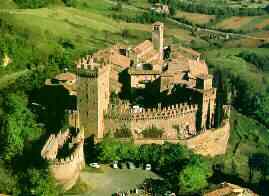
Cultural Institutions: Galleria d'Arte Moderna Ricci-Oddi (modern art gallery),
Museo Civico (museum), Galleria Alberoni (works of art by Antonello da Messina,
Salvator Rosa, Guido Reni) with library and Museo del Teatro (theatre museum).
In the Province: Corte Maggiore (methane and oilfields), Grazzano Visconti
(interesting village), Castell'Arquato (Museo Geologico, Museo della Collegiata),
Bobbio (Abbazia Benedettina di San Colombano, Benedictine Abbey), Fiorenzuola
d'Arda, Lugagnano Val d'Arda (archeological zone and Antiquarium di Velleia)
and Monticelli d'Ongina (Museo Etnografico del Po).
Ravenna (EMILIA-ROMAGNA)
Once situated on the Adriatic coast, Ravenna now
lies 12 km. away, though linked to the sea by a navigable canal, on the
plain between the Lamone and Uniti Rivers, to the south of the Comacchio
Valleys, 4 m. above sea level.
Founded according to Strabo by the Thessalians on some small isles which
later sank, under Roman domination, it grew in importance as a port, commercial
and military centre; in 409 AD. Honorius made it the seat of the Empire.
At the fall of the Empire, Ravenna became the capital of the Goths and then
of the Byzantines, enjoying a period of great prosperity under the latter
(6th-8th century).
After brief Lombard and Frankish domination, it passed to the Popes and
then to the German Emperors. In the period of the comuni the Signoria of
the Da Polentas became important; about the middle of the 15th century,
it fell to Venice, which at the beginning of the 16th century gave it to
the Pope.
Monuments: Basilica di San Vitale (Palaeochristian, 6th century), Mausoleo
di Galla Placidia (5th century), Battistero Neo niano (5th century baptistry),
Sant'Apollinare Nuovo (6th century, Aryan church erected by Theodoric, King
of the Goths, later reconsacrated as a Catholic church), San Giovanni Evangelista
(5th century), Battistero degli Ariani (5th-6th century baptistry), Chiesa
di San Francesco (10th century), Sepolcro di Dante (18th century, the
poet died in exile in Ravenna after a stay of four years with the Da Polenta
family), Palazzo degli Esarchi (8th century); 4 km away is Sant'Apollinare
in Classe (6th century), Byzantine mosaics); 2 km away is the Mausoleo di
Teodorico (6th century, Theodoric's mausoleum).
Apart from traditional agricultural activities, the city's economy is based
on an industrial sector which underwent radical development following the
discovery of natural gas to the north of the inhabited area in the early
1950's. This stimulated the petrochemical (large refineries) and chemical
(fertilizers, plastics) industries, which joined the existing textile and
food sectors. Ravenna is also an important commercial junction, based on
a busy trading port.
Events: Dantesque performances (14th September), `Ravenna Jazz' at the Rocca
Brancaleone (summer), Festival of organ music and ballet (summer).
In the Province: Faenza (ceramic production, Museo Internazionale delle
Ceramiche, Museo Torricelliano), Lugo (Museo Baracca), Cervia (seaside resort)
and Brisighella.
Reggio nell'Emilia (EMILIA-ROMAGNA)
 This
city lies on the fertile plain between the Enza and Secchia rivers, 58 m.
above sea level on the Via Emilia, in full view of the foothills of the
Tusco-Emilian Apennines.
This
city lies on the fertile plain between the Enza and Secchia rivers, 58 m.
above sea level on the Via Emilia, in full view of the foothills of the
Tusco-Emilian Apennines.
Once a Roman colony, it was the seat of a Duchy during the Lombard period,
and after domination by the Canossas, became a free municipality (12th century),
taking the side of the Lombard League against Barbarossa. It subsequently
passed under the rule of the Estense, Visconti, Gonzaga and Terzi families,
and was again under the Estenses until 1796, when the Napoleonic Cispadan
Republic was proclaimed there. On the 7th January in the following year,
the Italian flag was adopted as a symbol of the Republic. In 1859,
after the restoration, it was reunited with the Kingdom of Italy.
Monuments: Duomo (13th century, later additions paintings by Guercino
and Palma `il Giovane'), Chiesa di San Prospero (16th century), Santuario
della Madonna della Ghiara (17th century), Palazzo Comunale (Town Hall,
14th century, with the Sala del Tricolore) and Teatro Municipale (Neoclassical
theatre).
The economy of Reggio is based on flourishing commerce favoured by the excellent
communications network which serves the city, making it an important roadway
and railway junction. The industrial sector is constituted largely of small
and medium-sized firms, including the traditional activities connected with
agriculture (canning, wine and dairy factories which produce the famous
Parmigiano-Reggiano cheese).
Events: Rassegna Suinicola (pig show, spring), ornithological exhibition
(November).
Famous People: Ludovico Ariosto (poet, 1474-1533), Bartolomeo Spani (sculptor
and architect, 1468-1539), Angelo Secchi (astronomer, 1818-1878) and Antonio
Fontanesi (artist, 18331882).
Cultural Institutions: Galleria Parmeggiani (paintings from the Spanish
school); Musei Civici with: Collezione Spallanzani (natural history collection),
Museo del Risorgimento and Museo Archeologico (museums); Galleria d'Arte
Moderna (modern art gallery), Museo Paleontologico (paleonthological museum),
Museo di Storia Naturale (coin collections).
In the Province: Castelnovo ne' Monti (holidays at the foot of the Pietra
Bismantova), Correggio (Palazzo dei Principi, 16th century), Guastalla (Palazzo
Gonzaga).
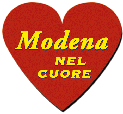

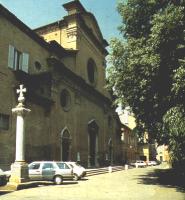

 [email protected]
[email protected]